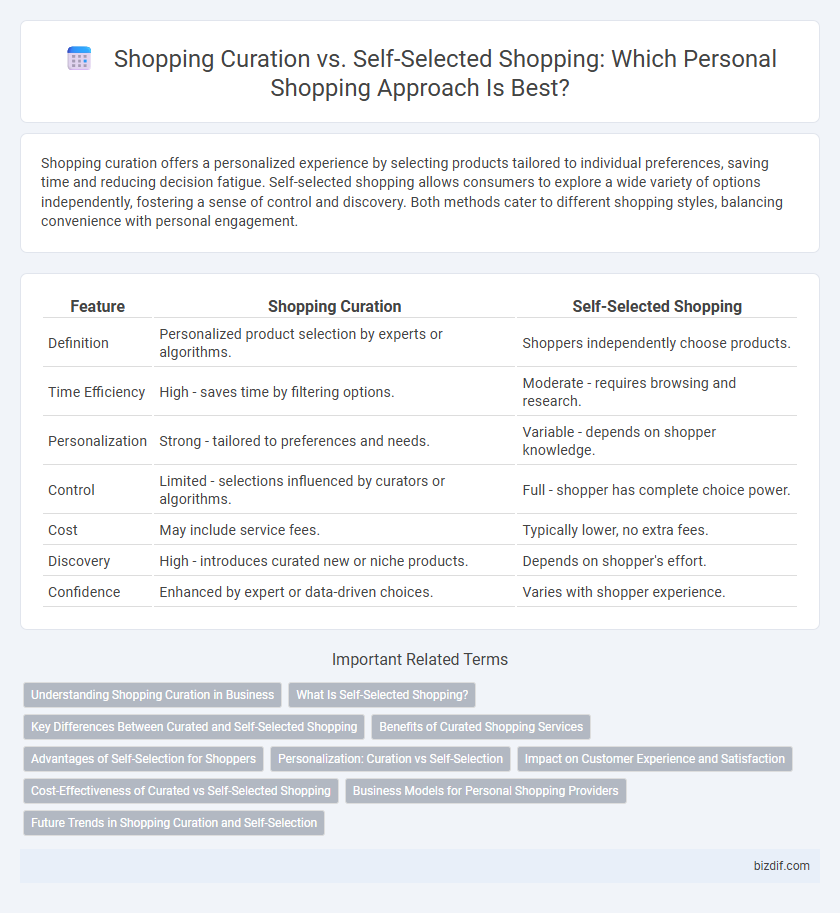Shopping curation offers a personalized experience by selecting products tailored to individual preferences, saving time and reducing decision fatigue. Self-selected shopping allows consumers to explore a wide variety of options independently, fostering a sense of control and discovery. Both methods cater to different shopping styles, balancing convenience with personal engagement.
Table of Comparison
| Feature | Shopping Curation | Self-Selected Shopping |
|---|---|---|
| Definition | Personalized product selection by experts or algorithms. | Shoppers independently choose products. |
| Time Efficiency | High - saves time by filtering options. | Moderate - requires browsing and research. |
| Personalization | Strong - tailored to preferences and needs. | Variable - depends on shopper knowledge. |
| Control | Limited - selections influenced by curators or algorithms. | Full - shopper has complete choice power. |
| Cost | May include service fees. | Typically lower, no extra fees. |
| Discovery | High - introduces curated new or niche products. | Depends on shopper's effort. |
| Confidence | Enhanced by expert or data-driven choices. | Varies with shopper experience. |
Understanding Shopping Curation in Business
Shopping curation involves experts selecting and organizing products tailored to specific consumer preferences, enhancing personalized shopping experiences and boosting customer satisfaction. Businesses leveraging curation benefit from increased sales, improved brand loyalty, and efficient inventory management by highlighting curated collections. In contrast, self-selected shopping places the decision-making burden on consumers, often leading to choice overload and less targeted purchasing behavior.
What Is Self-Selected Shopping?
Self-selected shopping involves consumers personally choosing products without external guidance, relying on their preferences, research, and experience. This approach offers complete control over the shopping process, enabling tailored decisions based on individual style, budget, and needs. It contrasts with shopping curation, where experts or algorithms recommend items, as self-selected shopping emphasizes autonomy and direct shopper engagement.
Key Differences Between Curated and Self-Selected Shopping
Shopping curation offers personalized selections based on expert insights, style preferences, and trends, enhancing convenience and reducing decision fatigue. Self-selected shopping allows individuals to explore a wide range of options independently, providing full control over choices but requiring more time and effort. Key differences lie in personalization, time investment, and the level of expertise guiding the purchase process.
Benefits of Curated Shopping Services
Curated shopping services provide personalized product recommendations based on individual preferences, saving time and reducing decision fatigue in the purchasing process. These services leverage expert knowledge and data-driven insights to deliver high-quality, relevant selections that enhance customer satisfaction. Consumers benefit from a more efficient and tailored shopping experience compared to self-selected shopping, which often involves overwhelming choice and increased effort.
Advantages of Self-Selection for Shoppers
Self-selected shopping offers shoppers complete control over product choices, enabling personalized decisions based on individual preferences and needs. This method encourages exploration and discovery, allowing consumers to directly assess quality, style, and price without external influence. The autonomy inherent in self-selection promotes satisfaction by aligning purchases closely with personal taste and budget constraints.
Personalization: Curation vs Self-Selection
Shopping curation offers highly personalized product recommendations based on individual preferences, style, and past behavior, enhancing the overall shopping experience by saving time and reducing decision fatigue. In contrast, self-selected shopping allows consumers full control to explore a wider variety of options independently, appealing to those who prioritize autonomy and specific item selection. The degree of personalization in curated shopping often leads to higher satisfaction and more relevant purchases compared to the broader, less tailored approach of self-selection.
Impact on Customer Experience and Satisfaction
Shopping curation enhances customer experience by offering personalized product recommendations tailored to individual preferences, saving time and reducing decision fatigue. Self-selected shopping provides autonomy and control, allowing customers to explore a wider range of products at their own pace, which can increase satisfaction for those who value independence. The impact on satisfaction depends on consumer behavior; curated shopping appeals more to those seeking convenience and expert guidance, while self-selection attracts shoppers prioritizing freedom and discovery.
Cost-Effectiveness of Curated vs Self-Selected Shopping
Shopping curation optimizes cost-effectiveness by leveraging expert knowledge to prevent unnecessary purchases and identify high-value items tailored to individual preferences. Self-selected shopping risks overspending due to impulsive buys and lack of market insights, often leading to redundant or unsuitable products. Curated shopping services also reduce time costs and enhance budget allocation efficiency compared to the trial-and-error nature of self-selection.
Business Models for Personal Shopping Providers
Personal shopping providers often adopt either a shopping curation model or a self-selected shopping model, each with distinct business strategies. The shopping curation model offers personalized product recommendations and tailored selections based on consumer preferences, leveraging data analytics and stylist expertise to enhance user experience and increase customer retention. In contrast, the self-selected shopping model empowers consumers with platforms that facilitate autonomous choice, focusing on user-friendly interfaces and extensive product catalogs to drive sales through convenience and variety.
Future Trends in Shopping Curation and Self-Selection
Shopping curation utilizes AI-driven algorithms and personalized data to deliver tailored product recommendations, enhancing customer experience and boosting conversion rates. Self-selected shopping increasingly integrates augmented reality and virtual try-ons, empowering consumers with immersive, interactive decision-making tools. Future trends emphasize hybrid models combining curated suggestions with autonomous exploration, leveraging machine learning and real-time analytics to optimize both convenience and personalization.
Shopping curation vs Self-selected shopping Infographic

 bizdif.com
bizdif.com